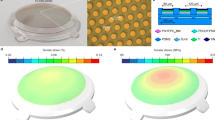Abstract
Eleven patients have received subretinal implants, powered and controlled via a subdermal cable that enters the body retroauricularly and ends in a thin intraocular foil, placed transsclerally between the retinal pigment epithelium and the neuroretina. The tip of this foil carries two distinct arrays, a Multiphotodiode Array (MPDA) with 1500 electrodes, each electrode being controlled by an adjacent photodiode and an amplifier within a 3x3x0.1 mm chip, as well as a second array (1.2x1.2 mm) with 16 electrodes, for direct stimulation (DS) controlled via wires from outside. Safety of the approach has been investigated by means of angiography, OCT and fundus photography. The implant was well tolerated in all patients. Efficacy has been investigated in terms of threshold voltages to elicit phosphenes and the ability to perceive visual information mediated by the MPDA. Patients were tested for 4 weeks and spatial as well as temporal characteristics of repetitive multielectrode-stimulation were investigated. Letters were presented to the 3 most recent patients either by stimulating retinal cells in 10 ms steps via individual electrodes in a sequence patients had learned to write such letters or - via the light sensitive chip - by individual bright letters or stripe patterns steadily presented at a screen in 62 cm distance.
It was shown that active subretinal multielectrode implants with currents close to recognition threshold (10 to 27 nC/electrode) produce retinotopically correct patterns that allow for the first time recognition of individual letters (8 cm high, viewed in appr. 62 cm distance) even at low luminance levels. Stripe patterns of moderate luminance can be resolved up to 0.35 cycles/deg via the subretinal chip. This clearly supports the feasibility of light sensitive subretinal multi-electrode devices for restoration of useful visual percepts in blind patients.
Access this chapter
Tax calculation will be finalised at checkout
Purchases are for personal use only
Preview
Unable to display preview. Download preview PDF.
Similar content being viewed by others
Author information
Authors and Affiliations
Editor information
Editors and Affiliations
Rights and permissions
Copyright information
© 2009 Springer-Verlag Berlin Heidelberg
About this paper
Cite this paper
Zrenner, E. et al. (2009). Subretinal Microelectrode Arrays Implanted Into Blind Retinitis Pigmentosa Patients Allow Recognition of Letters and Direction of Thin Stripes. In: Dössel, O., Schlegel, W.C. (eds) World Congress on Medical Physics and Biomedical Engineering, September 7 - 12, 2009, Munich, Germany. IFMBE Proceedings, vol 25/9. Springer, Berlin, Heidelberg. https://doi.org/10.1007/978-3-642-03889-1_119
Download citation
DOI: https://doi.org/10.1007/978-3-642-03889-1_119
Publisher Name: Springer, Berlin, Heidelberg
Print ISBN: 978-3-642-03888-4
Online ISBN: 978-3-642-03889-1
eBook Packages: EngineeringEngineering (R0)




